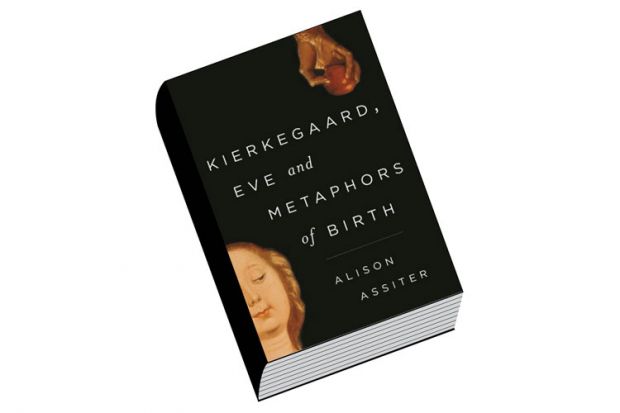This is not really a book about Søren Kierkegaard. Rather Kierkegaard is one figure in the transhistorical arsenal that Alison Assiter assembles to conceive of a philosophical future determined by new imagery and configurations, a future that dares to think about birth.
Philosophy has always been rather sniffy about birth. Aside from Hannah Arendt’s concept of natality and the work of certain feminist scholars (who are all too rarely granted the title “philosopher”), birth has largely been seen as a trivial and unphilosophical matter and banished to other disciplines. Death, however, is different. From Socrates’ cheery hemlock-draining to Heidegger’s being-towards-death and Walter Benjamin’s tragic wartime suicide, philosophy welcomes the thanatophile. It flaunts its familiarity with death – understood as a material reality with a rich theoretical significance – as a sign of its gravitas. Although it is disappointingly short on blood, mucus and placenta-scoffing, not only does Assiter’s book adeptly demonstrate that birth is a philosophical issue, it also succeeds in reframing Kierkegaard – the dour Dane, forefather of existentialism and Scandi-melodrama – as a dynamic thinker of life, not death.
Despite the book’s futural alignment, it is Kantian problems that provide its gravitational pull. Ostensibly, the central problem is that “of explaining how it is possible freely to do wrong”, but this weighty philosophical query is sharpened into the explicitly political: what does it mean to be human? What is the relationship between humans and the natural world? For Assiter, Kantian solutions fall short. Hampered by his commitment to a Newtonian worldview, Kant can view nature only as a determined system of mechanically connected, inert substances, dependent on an external rather than a biological ground, and the human subject as inescapably divided between natural desires and rational autonomy.
Assiter’s inventive assemblage of 19th- to 21st-century thinkers grounds a richer account of the interaction between human and non-human life forms, gesturing towards an escape from the Kantian orbit. From Friedrich Schelling, she takes metaphors of birth; from Kierkegaard, an embodied natural subject; from Slavoj Žižek, a focus on becoming; and from Quentin Meillassoux – a “speculative materialist” admonished by Assiter for being insufficiently speculative – she takes the notion of the “Grand Dehors”, an assertion that the world is not delimited by human thought. Freedom, too, extends beyond the human or rational, as “the emergence of the self or the entity from its ground”.
In unshackling Kierkegaard from the impoverished image of a Hegel-bashing religious extremist, Assiter liberates alternative readings of his strange and beguiling corpus. Although some of this strangeness is lost in her own forcefully instrumentalist reading, her Kierkegaard – a relational ontologist – fizzes with 21st-century relevance and her audacious reading undermines the feminist critiques that misread the ontological stakes. Kierkegaard, she tells us, was always too shrewd and serpentine to be the sexist we believed him to be.
Yet with all the time spent shuttling between centuries to weave a new ontology, and second-guessing philosophical criticisms, it is the feminism that feels underdeveloped here. We are encouraged to celebrate the crucial role of Kierkegaard’s female characters, who “express the finitude of human beings”, while noting that birthing imagery “need not be associated with any particular body”. But how does imagery intersect with lived experience? Isn’t there a danger that symbolic occupation of the figure of “woman” leads to what Catherine Malabou calls “a feminism without women”? Strapped for space, Assiter resists opening this particular can of worms; a loss, in the end, both for her argument and for current debates. A similar problem arises in the book’s endorsement of images of “Mother Nature” and of the gendering of “Gaia”, depicted in James Lovelock’s 2006 work The Revenge of Gaia as a near-parodic vengeful old crone. The eco-feminist debates raging in this area are unmentioned.
The best of this book comes when the philosophy spills over into other areas: the tangle between ecology, ontology and feminism; the bold repurposing of 21st-century realisms; the ethical rejection of a metaphysics of chaos; the whiff of a link between the fiercely religious Kierkegaard and a new vision of the political. Although these sections are all too short, it is here that Assiter’s book is fearless and arresting. Here, she offers a challenge to philosophy’s tendency to recycle old readings and preoccupations, and a timely reminder that philosophy may once again have something to say about the world.
Danielle Sands is lecturer in philosophy, Royal Holloway, University of London.
Kierkegaard, Eve and Metaphors of Birth
By Alison Assiter
Rowman & Littlefield, 224pp, £80.00 and £24.95
ISBN 9781783483242, 3259 and 3266 (e-book)
Published 16 May 2015
